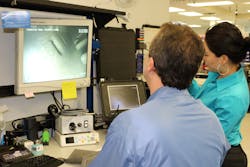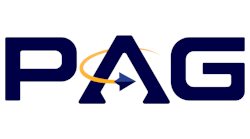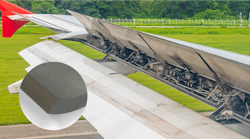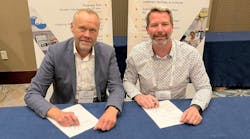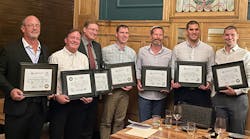Borescopes were first used in the medical market by doctors who used rigid scopes to view the vocal cords. Eventually, doctors started to use flexible glass fibers for endoscopy. It soon became adapted industrially and became a required tool by engine manufacturers and quality inspectors to inspect small passageways, dark cavities, and engine blades after regulated flight hours.
Q. Looking back over your career how has the NDT market changed?
The first industrial scopes I can recall were the flex fiberscopes that offered adequate resolution and lighting, but could not provide the images and video we know today. These scopes did not allow for video and images and if they did require taking photos, the operator would have to connect the scope to an add on camera and an additional monitor that weighed 78 pounds and recorded onto a VHS tape. Though effective, they were very heavy to move, and once the video option became available industrially, everyone was eager to upgrade.
The use of medical grade small diameter cameras, such as CCD, provide the best images in the market place today. These high-tech video borescopes allow engine manufacturers and maintenance personnel to detect the slightest cracks and defects and from a further distance when in the engine cavity. With chip technology getting smaller and smaller, we are able to build and provide scopes as small as 1.9 mm diameter.
There have also been enhancements to the added software technology provided in digital processors. What was once just being able to view and take photos has grown to video and taking stereo measurements. Also, we were able to enhance on the various tooling we could use these camera video chips with. We can now build videoscopes that allow for FOD removal and on-wing blade blending.
The industry continues to grow and improve upon the usages for video. It has been exciting to be able to watch the industry grow and adapt to the new technologies available.
Q. What are customers asking for today that they did not in the past?
Customers today are resourceful and informed with the help of publications like AMT, and internet searches. We find a lot of customers looking for scopes that can take both images and videos so that they can have digital photo files of their inspections. Customers might also ask about measuring engine cracks, and if it is necessary for their inspection requirements. We also find customers will ask about light control, resolution, and diameter. Being able to provide the right lighting, with high-quality resolution, and proper diameter, make all the difference in detecting cracks when inspecting dark engine cavities.
Q. How has technology affected what mechanics need in terms of tools and training?
The newer more advanced RVI video borescopes on the market today offer many options that help minimize engine downtime so that engine maintenance professionals can get planes back in the air faster. Some of these advanced systems require extensive training to be sure the information reported is accurate. For example, videoscopes that offer measurement require special training to ensure the information recorded is correctly within the limits. Without the proper training, an engine professional could accidentally provide incorrect measurements which could ground a plane with no need for an overhaul. This creates expensive costs to both the plane operator and MRO facility, and unneeded downtime.
It’s always important for technicians and mechanics to stay up to date with training and industry trends. Having the right training and proper tooling can minimize downtime, and in turn lower maintenance costs on equipment.
With information so accessible to the end user, it’s easier for everyone involved to read up on newer technologies which can bring MRO costs down.
Q. Has the use of borescopes/videoscopes changed over the years?
The new technology advancements have allowed borescope manufacturers to come up with new concepts and ideas that keep the engine on wing. Some of these advancements include FOD retrieval kits with mechanical fingers to grab items that have dropped into the engine, measuring scopes that allow for the ability to measure the smallest of cracks, and blending borescopes.
The blending scope, also referred to as Boro Blending, are highly sophisticated tools that will allow the user to remove blade damage within factory limits by using the borescope port. Using this tool keeps the engine on wing and avoids the expensive cost of overhaul.
Q. Is the aviation industry the largest customer for borescopes, what other industries are using borescopes?
A lot of the advancements to video have been primarily geared for the aviation industry. Aviation is the largest segment to use borescopes primarily for their engine requirements. That being said, with the changes to the technology now available, coupled with the ability to produce video, borescopes as small as 1.9 mm diameter are being used as an option to view small components in quality inspections in many more markets. Even the smallest available borescope with a CCD camera chip in a 2.4 mm diameter, has been quickly adapted by manufacturers of small parts due to the high image quality and durability.
Also, there is large usage of the newer advanced video borescopes by quality engineers, chemical refinery workers, weld inspectors, and specialized casting inspectors. The borescope is perfect for anyone in any industry who is looking to view small cavities that their eye can’t see.
Q. Who requests tool upgrades? Companies, managers, or technicians?
We receive tool requests from various markets from something as simple as gun barrel inspection to as advanced as engine inspections. Tooling requests come from a blend of engine manufacturers, maintenance personnel, their management, and quality engineers. With all the advancements in not only technology but information exchange, anyone can find industry information quickly and easily.
Here at Machida, when it comes to engine maintenance, it is important that all mechanics stay up to date with training and industry trends. Keeping them involved in the buying process can help with making sure your team is using the best equipment available. There is a lot of information available and it’s important that you are making the right choices for your shop. It’s easy to get hung up on price and forget to realize that the less-expensive units may not be approved for engine use and do not offer you opportunities for future upgrades or provide the right resolution that could make the difference in making those important engine calls.
Jitu Patel is the vice president of Machida Borescopes, a manufacturer of borescope tooling for engine inspection, FOD retrieval, and on-wing blade blending, headquartered in Orangeburg, NY. Jitu has been with Machida for over 40 years working directly with engine manufacturers providing custom solutions that eventually become industry standards. His years of inspection and engine knowledge make him the go to person for borescope questions and inspection needs. He can be reached by telephone at (845) 848-1080 or (800) 431-5420, and via email at [email protected].
